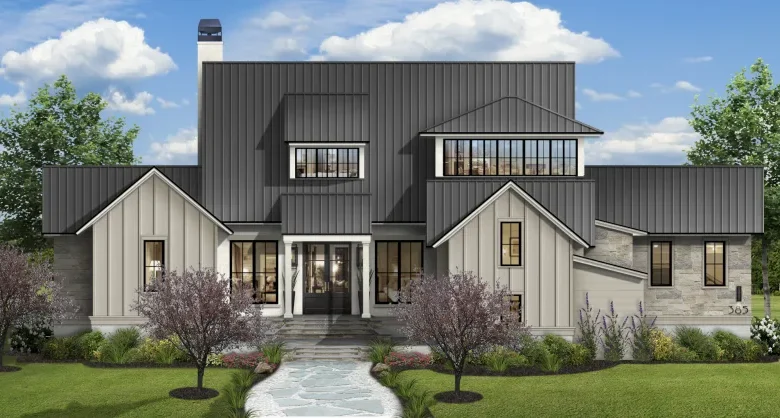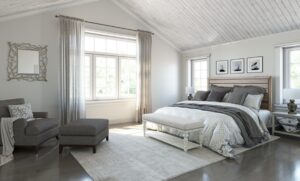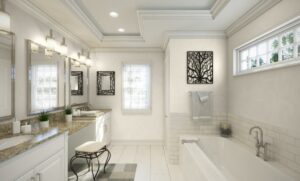Jogging Path by Sherwin Williams: A Comprehensive Guide

Choosing the right paint color for your home is an important decision that can greatly affect its overall look and feel. One color that stands out in the world of paint is Jogging Path by Sherwin Williams. This versatile shade has gained popularity for its warm, inviting tones that can complement a variety of architectural styles and design elements. In this article, we will explore what makes Jogging Path a great choice for your home, including its specifications, color pairings, pros and cons, and application recommendations.
What is Jogging Path?
Jogging Path is a warm greige color, a blend of gray and beige. This unique shade features strong khaki undertones, making it an excellent choice for those looking to achieve a cozy and inviting atmosphere. With an LRV (Light Reflectance Value) of 49, Jogging Path falls into the medium range of light reflectivity, which means it will reflect an average amount of light. This quality allows it to work well in both sunny and shaded areas, making it a versatile option for various exterior applications.
The color has an almost equal mix of red, green, and blue tones. However, because there is slightly more red in the mixture, Jogging Path appears more beige than gray. This subtle balance gives it a sophisticated and timeless feel that many homeowners appreciate.
The Versatility of Jogging Path

One of the standout features of Jogging Path is its versatility. This shade looks stunning on a variety of surfaces, including:
- Siding: Whether your home has traditional wood siding or modern composite materials, Jogging Path enhances the natural beauty of the texture.
- Stucco: The smooth surface of stucco can beautifully showcase the warm tones of Jogging Path, adding depth to the exterior.
- Brick: Jogging Path pairs exceptionally well with red brick, providing a lovely contrast that highlights the classic charm of brick homes.
Because of its adaptability, Jogging Path can suit both traditional and modern homes, making it a popular choice among designers and homeowners alike.
Color Pairings
Another reason Jogging Path is so beloved is its ability to pair well with various accent colors. Here are some combinations that work beautifully with this shade:
- Darker Hues: Pairing Jogging Path with deeper colors like Benjamin Moore’s Dragon’s Breath or Black creates a striking contrast that adds drama to your home’s exterior. This combination is perfect for those looking to make a bold statement.
- White Accents: For a classic look, consider using white trim with Jogging Path. This combination offers a fresh, clean appearance and is particularly suited for traditional-style homes.
- Pops of Color: If you want to add some fun to your exterior, consider using vibrant colors like Galapagos Turquoise for your front door. This bright hue can create an eye-catching focal point against the neutral background of Jogging Path.
With its warm undertones and flexibility, Jogging Path allows you to express your personal style while maintaining a cohesive look.
Pros and Cons of Jogging Path
Pros
- Adaptable and Versatile: Jogging Path complements a wide range of architectural styles, from craftsman to contemporary, making it suitable for many homeowners.
- Warm, Subtle Tone: Its warm greige hue creates an inviting atmosphere that enhances curb appeal.
- Great with Various Design Elements: Whether you have wood, brick, or iron accents, Jogging Path works harmoniously with different materials.
Cons
- Undertones Matter: The khaki and tan undertones may appear differently depending on the materials used in your home. It’s essential to test samples before committing to ensure it fits your vision.
- Neutrality: While many appreciate its subtlety, those looking to make a bold statement may find Jogging Path too neutral for their taste.
Application Recommendations

When applying Jogging Path, it’s crucial to consider a few key points:
- Test Before You Commit: Always sample the color on your home’s exterior before making a final decision. Natural light, surrounding colors, and the texture of your surfaces can all influence how Jogging Path appears.
- Consider Lighting Conditions: The color may look different at various times of day. Observe how it appears in the morning, afternoon, and evening to get a sense of its true character.
- Use Quality Materials: Investing in high-quality paint and tools will ensure a smoother application and a longer-lasting finish.
Conclusion
Jogging Path by Sherwin Williams is a versatile and timeless paint color that can enhance the beauty of your home. With its warm greige tones and strong khaki undertones, it works well with a variety of architectural styles and design elements. Whether you’re looking to create a traditional look with white accents or a modern aesthetic with bold colors, Jogging Path offers endless possibilities.
By considering its specifications, color pairings, and application recommendations, you can confidently choose Jogging Path for your next home improvement project. Remember to test samples and observe the color in different lighting conditions to ensure it meets your expectations. With Jogging Path, you can create an inviting and stylish exterior that reflects your unique taste and personality.
FAQs
1. What is Jogging Path by Sherwin Williams?
Jogging Path is a warm greige paint color from Sherwin Williams, characterized by its khaki undertones. It has an LRV (Light Reflectance Value) of 49, making it a medium shade that reflects an average amount of light, suitable for various exterior surfaces.
2. What colors pair well with Jogging Path?
Jogging Path pairs beautifully with a range of colors, including:
- Darker hues like Benjamin Moore’s Dragon’s Breath or Black for a striking contrast.
- White accents for a classic and fresh look.
- Vibrant colors like Galapagos Turquoise for accent features, such as front doors.
3. Can I use Jogging Path on different materials?
Yes! Jogging Path is versatile and can be used on various materials, including siding, stucco, and brick. Its warm tone enhances the natural beauty of these surfaces, making it suitable for both modern and traditional homes.
4. How do I ensure I choose the right color for my home?
It’s crucial to test samples of Jogging Path on your home’s exterior before committing. Factors like natural light, surrounding colors, and surface textures can affect how the color appears, so observe it at different times of day.
5. What are the pros and cons of using Jogging Path?
Pros:
- Adaptable and versatile, suiting many architectural styles.
- Warm and inviting tone that enhances curb appeal.
- Works well with various design elements and materials.
Cons:
- The color’s undertones may appear differently based on the materials used.
- Some may find it too neutral if they prefer bolder colors for their home’s exterior.

